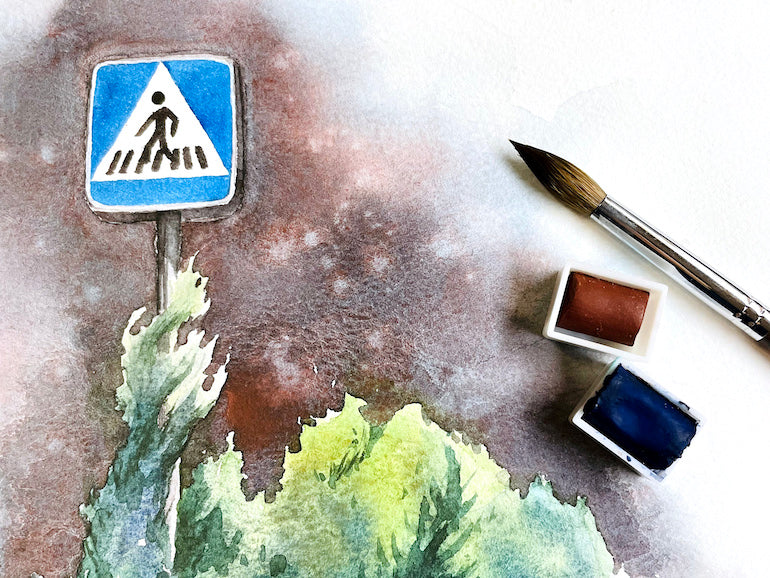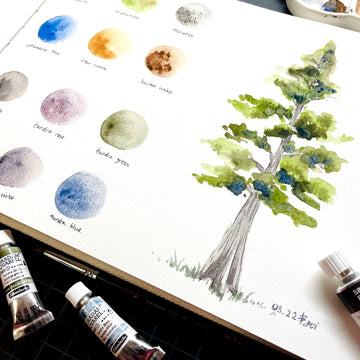A while back, I wrote a piece introducing watercolour granulation and explaining the basic principles behind it. So to avoid repeating myself, we’ll be taking a deeper dive into granulation, and look at some tried-and-true mixes to create granulating paints!
Single Pigments

As mentioned before, granulation happens when the pigments in paint form small clumps of colour on the paper’s surface. Since some pigments are coarser than others (even after going through the grinding process), they will naturally granulate. This is especially true for pigments made from pure minerals (i.e. stones) such as sodalite or hematite.
Tip: You can tell they’re mineral colours since most of them end in “-ite”, or sound like a rock or gem you might have heard of before, such as amethyst or lapis lazuli.
For this reason, they’re often more expensive than other paints, but there are a few that also granulate despite not being mineral-based. This includes:
- Ultramarine blue
- Cobalt blue
- Cobalt green
- Cobalt violet
- Perylene scarlet
- Potter’s pink
- Buff titanium
- Burnt umber
- Burnt sienna
- Raw sienna
You’ll notice that most granulating colours are blues and browns. Yellows and reds don’t granulate, so you may have to mix them with a granulating colour or medium if you do want them to granulate.

In any case, it’s sometimes difficult to see the granulation effect if you’re using a single-pigment paint (unless it’s one of the mineral ones), so it will help if you paint on paper that has a more textured surface, such as cold press or rough watercolour paper.
On hot press paper, the paint granules kind of float about while they’re still wet, before settling wherever they happen to dry.
Mixed Pigments
If you don’t want the hassle of mixing your granulating colours, you can buy granulating colours that were made to…well, granulate.
These are usually classified as “convenience colours”, as you could mix them yourself if you have the right paints. And the pigments used in these colours always granulate!
Bonus tip: If the different pigments contrast well with each other, the granulation effect is made more obvious. You can see this in the tundra green compared to the tundra blue.

When two or more different granulating colours interact, they tend to separate when suspended in water, as their slight difference in density will cause the heavier pigment to settle quickly, while the lighter one floats a little further before settling. You can see this effect in the swatch I’ve done above.
Tip: To get these colours to granulate properly, you should add a little more water than you normally would for watercolours. This is so the heavier pigments can move well, plus if it’s too dark, you won’t be able to see the effect very clearly.
Mixing Your Own

If you want to satisfy your inner chemist (or alchemist!), you can try creating your granulating colour mixes. One classic blend is burnt sienna and ultramarine blue! This combo creates a lovely neutral grey when mixed in relatively equal parts, and when diluted enough, separates into a beautiful contrast between blue and the orangey burnt sienna.
Another great combo is quinacridone violet and raw umber. Or how about raw sienna and phthalo blue? Just pick two granulating colours that you have, mix them, and swatch to see what the resulting colour looks like!
Why Granulate?
I know granulation isn’t for everyone. Some artists prefer a very smooth wash, which is great for a more illustrative style. However, if you’re interested in the more “wild side” of art, give granulation a try!
Since it’s not possible to control how a colour granulates, it makes it easier to just let go and let the pigments fall as they may. It’s also great to paint cloud formations with these paints! Other great subjects include bodies of water, or even landscapes and trees.
If you’re still not sure whether you like it or not, then give it a try and see. Who knows – you may discover your new favourite colour!
Do you like granulation in watercolour? If so, what’s your favourite granulating colour or combo? Let us know in the comments below!
Additionally, do consider subscribing to our email newsletter if you’re interested in art or learning more about it. You’ll be kept up to date with our latest workshop schedule and flash sales, too!



2 comments
Do high quality watercolor pencils granulated similar to watercolors?
Thanks
———
Etchr Lab replied:
> > Hi Theresa, It depends on the pigment more than the pencil itself. You > might want to check if you can find the pigment number for the pencil and > research if that is a granulating pigment. Some pencils dissolve better > than others, but they tend to leave the pencil markings even faintly. :) >
Great mini-guide to granulation here! Learned a few things I didn’t know about :) Thanks!